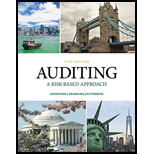
a
Concept Introduction:
Contingent liability is a potential liability under which outflow of resources is probable due to the happening of an uncertain future event.Contingent liabilities are not recorded in financial statements. Theseare only disclosed in notes to accounts.
Provision for contingencies:
Provision should be made for contingencies if it is probable that loss will occur, and the amount can be computed with reasonable certainty.
The auditor’s course of action if the given situation occurs.
b
Concept Introduction:
Contingent liability:
Contingent liability is a potential liability under which outflow of resources is probable due to the happening of an uncertain future event. Contingent liabilities are not recorded in financial statements. These are only disclosed in notes to accounts.
Provision for contingencies:
Provision should be made for contingencies if it is probable that loss will occur, and the amount can be computed with reasonable certainty.
The auditor’s course of action if the given situation occurs.
c
Concept Introduction:
Contingent liability:
Contingent liability is a potential liability under which outflow of resources is probable due to the happening of an uncertain future event. Contingent liabilities are not recorded in financial statements. These are only disclosed in notes to accounts.
Provision for contingencies:
Provision should be made for contingencies if it is probable that loss will occur, and the amount can be computed with reasonable certainty.
The auditor’s course of action if the given situation occurs.
d.
Concept Introduction:
Contingent liability:
Contingent liability is a potential liability under which outflow of resources is probable due to the happening of an uncertain future event. Contingent liabilities are not recorded in financial statements. These are only disclosed in notes to accounts.
Provision for contingencies:
Provision should be made for contingencies if it is probable that loss will occur, and the amount can be computed with reasonable certainty.
The auditor’s course of action if the given situation occurs.
Trending nowThis is a popular solution!

Chapter 14 Solutions
Auditing: A Risk Based-Approach (MindTap Course List)
- Define and differentiate between capital expenditure and revenue expenditure. Why is it important for businesses to classify these correctly in financial statements? Support your explanation with at least one example for each type of expenditure.arrow_forwardWhat are the total overhead costs assigned to Job 101?arrow_forwardSubject : Financial Accountingarrow_forward
- Solve this questionsarrow_forwardOptical Company estimates its manufacturing overhead to be $540,000 and its direct labor costs to be $450,000 for year 2. Optical worked three jobs for the year. Job 2-1, which was sold during year 2, had actual direct labor costs of $150,000. Job 2-2, which was completed, but not sold at the end of the year, had actual direct labor costs of $275,000. Job 2-3, which is still in work-in-process inventory, had actual direct labor costs of $100,000. The actual manufacturing overhead for year 2 was $600,000. Manufacturing overhead is applied on the basis of direct labor costs. a) How much overhead was applied to each job in year 2? b) What was the over-or underapplied manufacturing overhead for year 2?arrow_forwardPlease provide the accurate answer to this financial accounting problem using valid techniques.arrow_forward
 Auditing: A Risk Based-Approach (MindTap Course L...AccountingISBN:9781337619455Author:Karla M Johnstone, Audrey A. Gramling, Larry E. RittenbergPublisher:Cengage Learning
Auditing: A Risk Based-Approach (MindTap Course L...AccountingISBN:9781337619455Author:Karla M Johnstone, Audrey A. Gramling, Larry E. RittenbergPublisher:Cengage Learning Auditing: A Risk Based-Approach to Conducting a Q...AccountingISBN:9781305080577Author:Karla M Johnstone, Audrey A. Gramling, Larry E. RittenbergPublisher:South-Western College Pub
Auditing: A Risk Based-Approach to Conducting a Q...AccountingISBN:9781305080577Author:Karla M Johnstone, Audrey A. Gramling, Larry E. RittenbergPublisher:South-Western College Pub- Business/Professional Ethics Directors/Executives...AccountingISBN:9781337485913Author:BROOKSPublisher:Cengage



